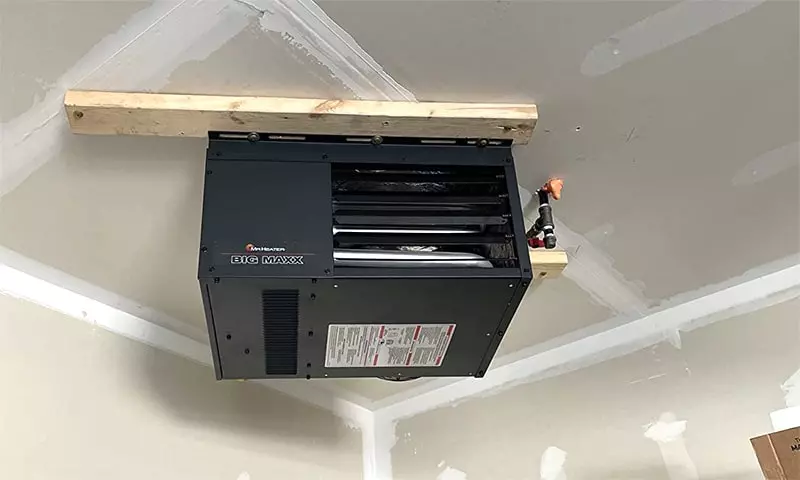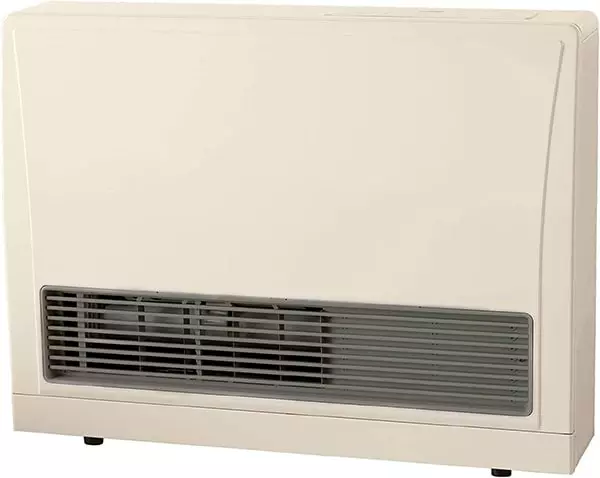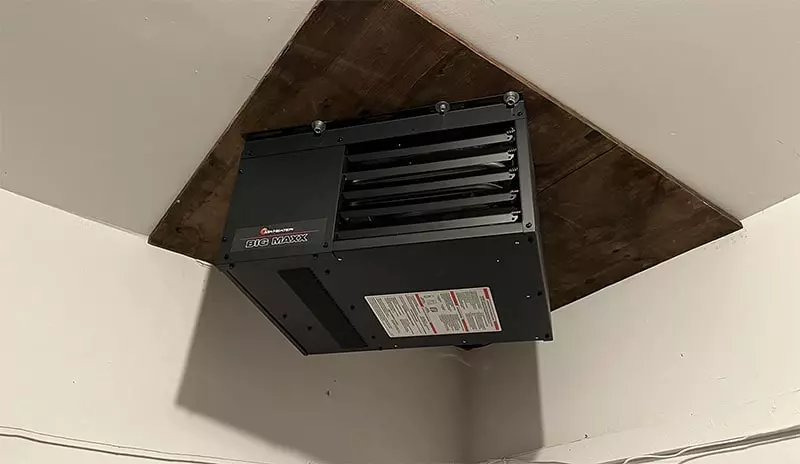Being a heating blogger and an electrical engineer, the internet never ceases to disappoint me. When I looked for the best vented gas heaters online, I found only bogus results.
Almost every article recommended heaters that looked like vented gas heaters but were actually ventless. Heck, even Walmart fails to differentiate between ventless and vented gas heaters when you use their search option.
In this article, we’re going to check out the best & truly vented gas heaters. Spoiler: There are tons of choices, but only a few are good.
So, instead of listing all the heaters that I can think of, I am going to provide you with only the 3 absolute best heaters.
Quality is better than quantity!
So, let’s have a look:
1. The best: Mr. Heater Big Maxx (50,000 BTU)
The best vented gas heater is the Mr. Heater Big Maxx (click here to view it on amazon) in its 50,000 BTU version.
With a heat output of 50,000 BTU per hour, it is hot enough to heat even the largest living rooms, garages, basements, and whatever large space you can think of.
I ranked this heater number one because nothing can beat the quality of the Mr. Heater’s full-metal case, which makes it extra safe and extra durable.
Metal cases never melt, nor do they ever discolor like plastic. So, the Mr. Heater Big Maxx will look just the same in 10 years as it does now.
In contrast to most other heaters, which stand on the floor or are wall-mounted, you can mount the Mr. Heater Big Maxx to your ceiling.
There it takes up no space.
So, it is perfect for rooms where you don’t have much space left to install a heater.
And, additionally, the Mr. Heater Big Maxx is the absolute safest propane heater (Yup, it even won this award on heatertips.com).
First and foremost, it comes with all the safety features you need, including overheat protection and a built-in fan that prevents heat buildup inside the heater.
But since you can ceiling-mount the Mr. Heater Big Maxx, it is a perfect choice if you have kids or pets at home.
The heater is completely out of reach for them.
I’d say the Mr. Heater Big Maxx is best for any indoor spaces in single-family homes, including living rooms, garages, and wood workshops.
Heat output50,000 BTUCompatible gasNatural gas (default) and propane (conversion kit included)Best forLarge living rooms, garages, workshops, and basementsMount-typeCan be mounted to the ceiling, so it takes up no space
2. The big brother: Mr. Heater Big Maxx (80,000 BTU)
The Mr. Heater Big Maxx comes also in larger variants including its 80,000 BTU version(click here to view it on amazon).
There’s also an even bigger Big Maxx heater but that one is better for industrial applications.
You should get the 80,000 BTU Big Maxx over the 50,000 BTU version for heating large & uninsulated spaces.
So, get the 80,000 BTU Mr. Heater Big Maxx for your uninsulated garage, your uninsulated wood workshop, or your uninsulated living room (eg. in a cabin).
It’s also a great choice for old buildings with heavy, solid, and cold stone walls. These tend to absorb a lot of heat and increase the heat-up time of your house a lot.
You can circumvent this using the 80,000 BTU Big Maxx.
I intentionally placed the Big Maxx models rank 1 and 2 to make clear that to this day I did not meet a gas-based heater that beats the quality of Mr. Heater.
For most people, the “small” 50,000 BTU version is more than enough.
Heat output80,000 BTUCompatible gasNatural gas (default) and propane (conversion kit included)Best forLarge uninsulated living rooms, garages, workshops, and basementsMount-typeCan be mounted to the ceiling, so it takes up no space
3. Best for living rooms: Rinnai EX22CTWP (20,700 BTU)
This 20,700 BTU Rinnai Direct-Vent Propane Heater(click here to view it on amazon) is the best vented propane heater for most indoor spaces, such as living rooms, bedrooms, kitchens, etc.
In comparison to the previous two heaters (the Big Maxx models), the Rinnai direct-vent propane heater looks a lot less bulky and integrates better with most living rooms.
It looks just like a regular heater.
Of course, it comes with the necessary safety mechanisms such as overheat protection and a built-in thermostat.
What I like most about the Rinnai heater is the automatic restart in case the combustion fails.
Most propane heaters monitor their combustion with a so-called pilot light. That’s a small gas flame that is branched off the main gas line. A thermocouple (which is a specific form of thermometer) then measures the temperature of the pilot light flame.
If the flame is hot, then the heater opens the main gas line. Because a hot pilot light flame indicates that everything works fine.
However, if the pilot light flame is too cool, the heater automatically closes the main gas line. A too-cool gas flame indicates incomplete burn which protects you both from wasting money (because the gas doesn’t produce enough heat), and from carbon monoxide production.
The special thing about the Rinnai heater is that it tries to restart the flame ignition in this case.
With most other propane heaters, you have to restart the ignition manually.
The only downside of the Rinnai heater is the case material (which is plastic). Over time, plastic always degrades. Whether it is through spots that overheat and melt or through discoloring.
Still, it is a great direct-vent heater. In fact, the Rinnai heater is the best free-standing or wall-mounted direct-vent heater.
 Heat output20,700 BTUCompatible gasPropane gasBest forRegular-sized living rooms, insulated garages, workshops and basementsMount-typeWall-mounted or free-standing
Heat output20,700 BTUCompatible gasPropane gasBest forRegular-sized living rooms, insulated garages, workshops and basementsMount-typeWall-mounted or free-standing
Can you run vented gas heaters without electricity?
No, you can’t run a vented gas heater without electricity. None of the heaters recommended above work without electricity. So, you can’t use them as backup heat sources during an electricity outage (unless you have a generator).
Vented gas heaters are intended to replace a central heating system. Manufacturers design them to output a lot of heat while still remaining safe.
Designing a safe, but very hot heater is almost impossible without electronics. Electronics are what make these heaters affordable.
To safely control such strong gas heaters, they need at least one of two things:
- a thermostat that controls the heat output
- a built-in fan to blow the heat into the room, protecting the heater from overheating
Both of these features need electricity.
Direct-vent heaters don’t work without electricity. So, you can’t light a vented gas heater during an electricity outage.
If you are looking for a heater to rely on during outages, you have to get a ventless heater.
Check out the best ventless propane heater here: My favorite propane heater
When to pick a vented gas heater over a ventless heater?
Ventless heaters are abundant. There are dozens if not hundreds of good heaters, most of them without any vents.
So, in which case should you prefer the vented heaters recommended in this article over a ventless heater?
In general, vented gas heaters are best when you need a strong heat source that can safely keep an entire house warm. Vented heaters can replace a central heating system.
High heat output
Usually, direct-vent heaters are significantly stronger than ventless gas heaters. For the same price, you usually get double the heat output.
Some vented heaters (such as the ones recommended at the beginning of this article) get hot enough to replace your central heating system and keep your entire home warm during winter.
No toxic waste gases
Since vented heaters are - by definition - vented, it is impossible for them to produce any toxic waste gases.
And even if they produce any, these waste gases go right out the vent.
So, toxic heaters are much safer to run continuously for long times, without having to open the windows regularly.
No water vapor
Also, propane gas (if you pick a vented propane heater) produces water vapor during the combustion. This increases your room’s humidity.
With a vented heater, the water vapor leaves through the vent and doesn’t enter your living space.
So, it keeps your room warm and dry. During the cold season, getting any humidity out of a room is very hard, especially if you live in a humid place.
With a vented heater you don’t even introduce any additional humidity to your room.
No smell
Whenever I enter a room with a gas heater, I immediately notice the smell. Even when the heater is not running.
Natural gas and propane have a very distinct smell. Both natural gas and propane naturally are odorless.
But gas companies add a smelling additive for safety reasons.
Vented heaters don’t smell as much.
To be honest, I like the smell. But it’s similar to many people liking the smell of a mowed lawn on a summer morning. It smells good. Nobody can explain why. But you also don’t want your living space to smell like that continuously.
Conclusion
Vented heaters replace central heaters, while ventless heaters are supplemental heat sources.
The best vented gas heaters are the Mr. Heater Big Maxx models and the Rinnai direct-vent heater.
All three of them are very solid and high-quality choices that can keep you warm throughout the winter!
My personal favorite is the 50,000 BTU Mr. Heater Big Maxx model. It is strong enough to keep your entire house warm, and it has all the safety features you need.
Plus, you can install it to your ceiling so it does not take up any floor space!
